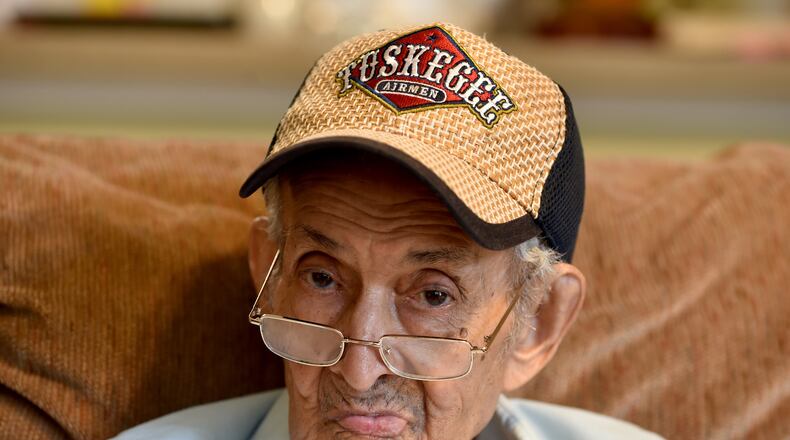NORRIS CONNALLY
Age: 94
Residence: Atlanta
Service: U.S. Army/Air Forces, plane crew chief, 15th Air Force, 99th Fighter Squadron, 332nd Fighter Group
Sitting in his living room recounting what happened to him 70 years ago in Italy still makes Norris Connally smile. The Atlanta native, a Morehouse College student at the time, was chosen to become part of the first class of Tuskegee Airmen and was sent overseas during World War II.
Despite having limited ability to speak these days due to health reasons, Connally gets emotional when the subject is broached. He was part of the 99th Fighter Squadron that arrived in Morocco in April 1943. A year later, they joined the 100th, 301st and 302nd squadrons in the 332nd Fighter Group that was stationed at Ramitelli, Italy.
He served as a mechanic, prop specialist, engine specialist, technician and crew chief on seven types of aircraft. One of those was the famous P-51 Mustang, distinguishable by its bright red tail – leading to the 332nd’s nickname, the “Red Tails.”
His work helped pave the way for African-American aviation in the armed forces, and he saw places he had only heard about in school, like the Vatican. But he most enjoys remembering the dances he attended while stationed in Ramitelli. Asked if he had danced with the pretty Italian women in town, Connally almost giggled. It was obvious it was a time in his life he still cherishes.
But for African-Americans during World War II, not everything was pretty. Connally’s daughter, Geraldine Gilliam, recalled that her father discussed how the black airmen were often treated better in those Italian towns than they were by American white airmen.
Gilliam said her father’s experience with racism might have been somewhat different from most African-Americans’ because he was light-skinned, but “not just in Tuskegee, but all over the country, if they knew what race he was, he was not allowed to go in. That was part of the times.”
Connally’s aviation experience began when Army Air Force recruiters came to the Morehouse campus in 1941 looking for recruits. He and 79 others from various local black schools signed up and were sent to Chanute Field in Illinois, where they learned how to prepare and maintain airplanes.
Because he earned high honors on the air corps examination, Connally was placed in charge of the group. He appeared well on his way to becoming a fighter pilot – until the group returned to Alabama a few months later. That’s when only five earned their wings. The other 75 were made part of the ground crews, including Connally.
In an interview with Georgia Public Broadcasting as part of its oral history project about World War II, he discussed the slight.
“That was one of the most disappointing things that happened to me,” he said, “because I had wanted to fly since I was a little boy.”
Connally and his fellow black airmen set out not just to equal the performance of their white counterparts, but to surpass it. In an interview with the National Park Service in 2001, he talked about how they knew they were being watched — and how they were expected to fail.
“I think the most challenging thing was the attitude that a lot of people had that we were not going to succeed, and that made everybody want to succeed more because they said black folk didn’t have sense enough to fly airplanes.”
Through the years, Connally recounted instances of racial discrimination in Illinois and while back in Tuskegee. Asked if being black at the time was difficult, he responded, “Oh yeah.”
The 99th flew with the British 8th Air Force while in Europe, and when the entire 332nd was at full strength, they became well-known for escorting U.S. bomber squadrons on missions into Germany. Through most of their stay in Italy, the black airmen were stationed at a separate base from white airmen.
Gilliam recounted a story her father told her about that experience.
“They sent all the white soldiers, white pilots and everyone, to one base and they left the black soldiers and pilots and planes at another base. … And the Germans found out that the white planes and pilots were at this other base and they went and bombed them. Daddy said it was one of the times it paid off to be black because they didn’t get bombed.”
Upon his return to the U.S. in 1946, Connally said he was told he passed the flight officer’s exam and that he could report for flight training. A staff sergeant at the time, Connally sternly declined.
“When I wanted to fly, y’all wouldn’t let me fly,” he said during the Park Service interview. “I’m going back to college.”
Those around him say Connally was always proud of being a DOTA — Documented Original Tuskegee Airman. He had said the experience prepared him for the rest of his life.
“The Army Air Force helped me develop how to get along with people, how to deal with people, and so did the field training I got,” he said during the Park Service interview. “So all of it was very valuable in helping me with my career.”
After the war: Connally returned to his studies at Morehouse and later attended Atlanta University. He then went to work at Atlanta Life Insurance Co. and remained there until 2002, retiring as senior vice president, general auditor and vice chairman of the board of directors.
About the Author
Keep Reading
The Latest
Featured


